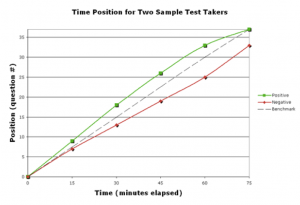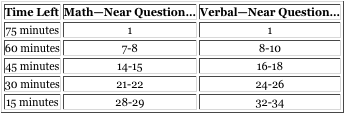-
Target Test Prep 20% Off Flash Sale is on! Code: FLASH20
Redeem
Critical Skill Development: Time Management
 This weeks article is adapted from an article about Time Management, originally written in 2006 for the ManhattanGMAT Strategy series. Ive excerpted some parts of that original article and Ive also added to the article to reflect more recent insights into the test.
This weeks article is adapted from an article about Time Management, originally written in 2006 for the ManhattanGMAT Strategy series. Ive excerpted some parts of that original article and Ive also added to the article to reflect more recent insights into the test.
Time management is obviously an essential GMAT skill, and one of the (many!) skills we need for this test is the ability to maintain an appropriate time position. Time position refers to the relationship between the test takers position on the test (the question number) and the time that has elapsed to get to that point in the section. For example, if Ive just finished quant question #5 and 15 minutes have elapsed so far, am I ahead, behind, or on time?
In my previous example, I would be behind on time because, on quant, were expected to average about 2 minutes per question. After 5 questions then, only 10 minutes should have elapsed so I am 5 minutes behind, giving me a negative time position.
Ideally, wed like to remain neutral throughout the test, which means that were within two to three minutes of the expected time. Sometimes, though, were going to get off track. When this happens, is it better to be positive or negative?
Most people will find themselves in the negative position more frequently than the positive position and this is exactly the opposite of what we would want. If we have to be off on our timing, its better to be ahead than behind (though the ideal scenario is to be neutral as much as possible). Why is it better to be positive than negative if we get off track?
Two test takers time positions (using the quantitative section of the GMAT as an example, 37 questions, 75 minutes) are illustrated below:

The dashed gray line represents the benchmark time position for the quantitative section of the GMAT. This benchmark is calculated by taking the total time and dividing it by the total number of questions on the section (75 min / 37 questions = approximately 2 min/question). The green test taker is working at a pace above the benchmark (positive time position) and, as a result, is able to complete the section either early or on time. The red test taker is working at a rate below the benchmark (negative time position). In this case, the red test taker consistently falls behind the benchmark pace and, unless she changes her strategy in the middle of the test in order to catch up, is only able to finish 33 out of the 37 quantitative questions.
For some, maintaining a neutral or positive time position comes naturally. However, for most of us, the time pressure is too tight, and we find ourselves behind at some point. So, how do we develop the skill to maintain a neutral time position?
1. Understand how the scoring works
First, everyone gets a lot of questions wrong, no matter the scoring level; thats just how the test works.
Second, getting an easier question wrong hurts your score more than getting a harder question wrong. In fact, the easier the question, relative to your overall score at that point, the more damage to your score if you get the question wrong. (Note: it is still very possible to get the score you want even if you make mistakes on a few of the easier questions.)
Third, getting three or four questions wrong in a row hurts your score more, on a per-question basis, than getting the same number of questions wrong but having them interspersed with correct answers. In other words, the effective per-question penalty actually increases as you have more questions wrong in a row. This, of course, is exactly what happens to someone who maintains a negative time position on the test; even if you notice and try to catch up toward the end, youre likely to end up with a string of wrong answers in a row.
Finally, the largest penalty of all is reserved for not finishing the test another possible consequence of maintaining a negative time position.
2. Keep a single-problem time log
When practicing GMAT problems, ALWAYS keep track of the time. Try to work within the following time constraints for any individual problem:
Quantitative: 2 minutes; max of 2.5 minutes
Sentence Correction: 1 minute 15 seconds; max of 2 minutes
Critical Reasoning: 2 minutes; max of 2.5 minutes
Reading Comprehension: 2 to 3 minutes to read (depending upon length); 1 minute for general questions; 1.5 to 2 minutes for specific questions
Keep a time log that reflects the time spent on EVERY problem; each individual problem gets its own row in the log. (Note: if youre taking our course, use the OG Tracker spreadsheet when doing OG problems and the calculations will be done for you.) Entries in the time log might look like a rough version of this:
On the Data Sufficiency question, the test taker had a negative 10 second position; on the Sentence Correction question, the test taker had a positive 15 second position, and so on. Group the question types together in the log (so, instead of mixing types as the above chart does, keep one log for Data Sufficiency questions, a separate log for Sentence Correction questions, and so on).
3. Reflect on the Results
The log will make you aware of your pacing on a single-problem level, and will force you to consider the time as you work through a practice problem. Aggregate the data to determine those question types that are generally costing you time (a significantly negative time position overall) and figure out what you need to do to become more efficient (where you can) and, when necessary, how to tell when you should make an educated guess and move on before youve already lost too much time. (And then, of course, learn how to make good educated guesses!)
Also notice those questions that are buying you time (a significantly positive time position overall). First, make sure that you are not making many careless mistakes with these; working quickly is never a positive thing if you sacrifice a question that you were capable of answering correctly. You may actually need to slow down on some of these in order to minimize your careless mistakes.
If you do find areas that are both highly accurate and very efficient, excellent; these are your strengths and you should be very aware of those while taking the test. For instance, if you discover that youre in a negative time position, you should still take your normal amount of time to answer any strength questions; dont sacrifice the ones you can answer correctly! Instead, make a random guess on the next weakness question that you see in order to get yourself back to a neutral position.
4. Transition to Benchmarks
While keeping a single-problem time log will help you become aware of your pacing on all question types, its certainly not a practical way to monitor the time during the actual exam. First, checking the clock after each problem on the actual exam is too much of a distraction. Second, to be an effective time manager, you must be flexible. You may be able to complete a slightly easier math problem in fewer than 2 minutes, and you may need slightly more than 2 minutes for the more difficult problems. For these two reasons, its much easier to monitor time on the actual exam using these 15 minute benchmarks:
Keeping track of the timing for question blocks, as opposed to individual questions, allows for flexibility: less time on the slightly easier questions, more time on the difficult questions though within reason (dont spend more than 30 seconds above the expected average for that question type).
Once you feel comfortable with the single-problem time log, begin to transition to the 15 minute benchmarks. To practice, take a block of 7 or 8 math problems and allot yourself 15 minutes. Are you maintaining a neutral-to-positive time position for an 8 question block? Do the same for a block of verbal questions and monitor your progress.
By the time the actual exam rolls around, youll know how to use these 15 minute benchmarks to monitor your time position and maintain a neutral-to-positive position throughout!
Recent Articles
Archive
- April 2024
- March 2024
- February 2024
- January 2024
- December 2023
- November 2023
- October 2023
- September 2023
- July 2023
- June 2023
- May 2023
- April 2023
- March 2023
- February 2023
- January 2023
- December 2022
- November 2022
- October 2022
- September 2022
- August 2022
- July 2022
- June 2022
- May 2022
- April 2022
- March 2022
- February 2022
- January 2022
- December 2021
- November 2021
- October 2021
- September 2021
- August 2021
- July 2021
- June 2021
- May 2021
- April 2021
- March 2021
- February 2021
- January 2021
- December 2020
- November 2020
- October 2020
- September 2020
- August 2020
- July 2020
- June 2020
- May 2020
- April 2020
- March 2020
- February 2020
- January 2020
- December 2019
- November 2019
- October 2019
- September 2019
- August 2019
- July 2019
- June 2019
- May 2019
- April 2019
- March 2019
- February 2019
- January 2019
- December 2018
- November 2018
- October 2018
- September 2018
- August 2018
- July 2018
- June 2018
- May 2018
- April 2018
- March 2018
- February 2018
- January 2018
- December 2017
- November 2017
- October 2017
- September 2017
- August 2017
- July 2017
- June 2017
- May 2017
- April 2017
- March 2017
- February 2017
- January 2017
- December 2016
- November 2016
- October 2016
- September 2016
- August 2016
- July 2016
- June 2016
- May 2016
- April 2016
- March 2016
- February 2016
- January 2016
- December 2015
- November 2015
- October 2015
- September 2015
- August 2015
- July 2015
- June 2015
- May 2015
- April 2015
- March 2015
- February 2015
- January 2015
- December 2014
- November 2014
- October 2014
- September 2014
- August 2014
- July 2014
- June 2014
- May 2014
- April 2014
- March 2014
- February 2014
- January 2014
- December 2013
- November 2013
- October 2013
- September 2013
- August 2013
- July 2013
- June 2013
- May 2013
- April 2013
- March 2013
- February 2013
- January 2013
- December 2012
- November 2012
- October 2012
- September 2012
- August 2012
- July 2012
- June 2012
- May 2012
- April 2012
- March 2012
- February 2012
- January 2012
- December 2011
- November 2011
- October 2011
- September 2011
- August 2011
- July 2011
- June 2011
- May 2011
- April 2011
- March 2011
- February 2011
- January 2011
- December 2010
- November 2010
- October 2010
- September 2010
- August 2010
- July 2010
- June 2010
- May 2010
- April 2010
- March 2010
- February 2010
- January 2010
- December 2009
- November 2009
- October 2009
- September 2009
- August 2009


